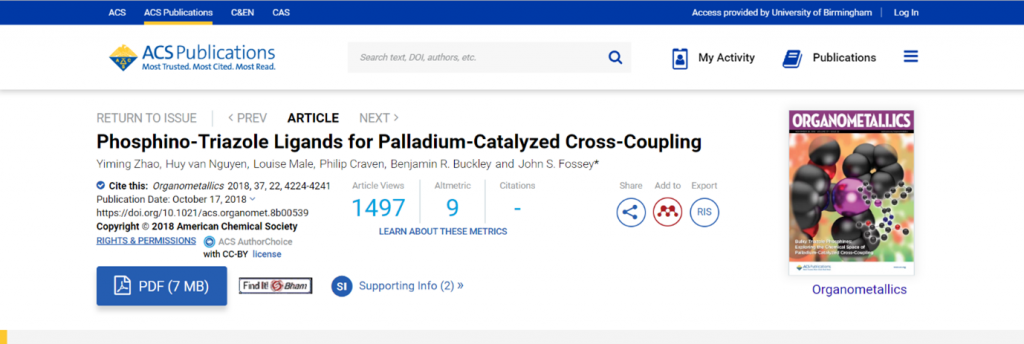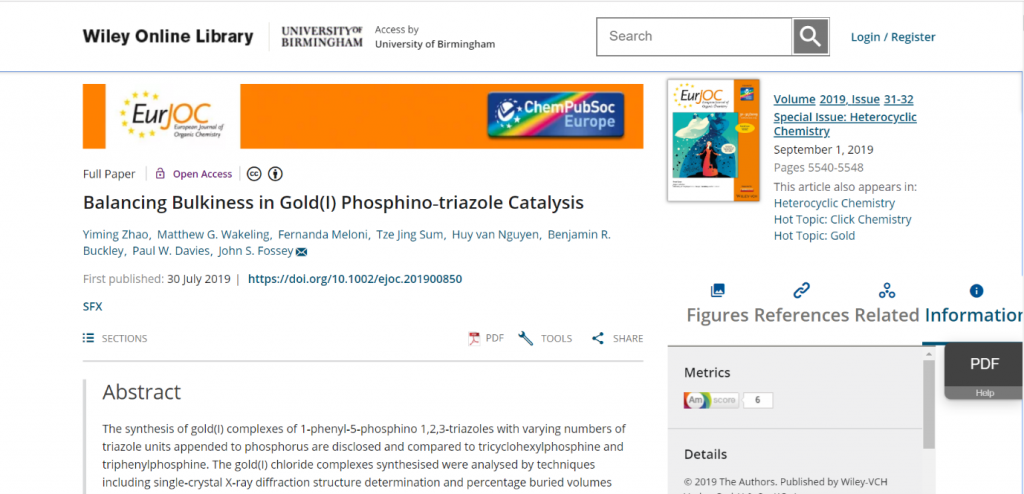NEWS
NEWS, ACTUALITIES, HAPPENINGS, CONFERENCES AND EVERYTHING ELSE THAT IS RELATED TO THE NEURAM PROJECT
Publication in Nature Communications, 10 from 11 February 2019.
The full article can be seen here: https://www.nature.com/articles/s41467-019-08487-5

Publication in Organometallics 2018, 37 (22) from 17 October 2018.
The full article can be seen here: https://pubs.acs.org/doi/pdf/10.1021/acs.organomet.8b00539

Publication in European Journal of Organic Chemistry EurJoc from 30 July 2019.
The full article can be seen here: https://onlinelibrary.wiley.com/doi/epdf/10.1002/ejoc.201900850

NEURAM REVIEW MEETING
13 November 2018 in Brussels
FROM IDEA THROUGH INVENTION TO INNOVATION
First is the spark, then the creativity, then the grant writing finally the implementation. Easy!

This is the short story of the NEURAM project.
THE BEGINNING: IDEA CREATION
How do you start a research project that ends up receiving €4.27 million from the European Commission? It is not too dissimilar to a “normal” national research grant except that you also need to find international experts who are willing to participate. This project started at the University of Birmingham where three of the principal investigators (Fossey, Mueller, Sik) work. The latter two work in the same building and also hold a British Heart Foundation project together already. So, it is natural that they would talk about science questions, new opportunities, fascinating technologies and so on. During one of the chats Ferenc (Mueller) mentioned an article where Raman spectroscopy was used to see genetic materials in fixed (dead) cells. This is definitely his field: he knows everything about genes, transcriptions, and all the complicated processes that happen in cells. Attila knows a lot of small things in many fields, many are useless, and some are occasionally useful. His input here was some knowledge on Raman spectroscopy that he briefly used in an arts project to identify the age of Chinese cloisonné objects (ancient metalwork objects that have nothing to do with biology). On top of that he knew the funding members of the microscopy company Femtonics in Budapest, Hungary where he worked many (many, many… ) years ago. After the initial idea had bounced around for a while, it looked feasible that with stimulated Raman spectroscopy (SRS) the transcription (the first step of gene expression, in which a particular segment of DNA is copied into RNA) can be visualized in living cells. Since Attila is a neurobiologist, the obvious target of where to look at gene transcription was the brain. Because Ferenc works on zebrafish (little creatures that geneticists love due to their transparency) the project was formulated: investigate how genes are copied to RNA using SRS first in the zebrafish brain, then move to more complicated systems, such as mouse and human brains.
THE BEGINNING: TEAM BUILDING
Generating the idea is the first step in a complex project, but it will not go very far if you don’t have the right network of colleagues to help get it off the ground. Fortunately Balazs Rozsa and Gergely Katona (Femtonics) knew an expert in the spectroscopy field, who already had experience in Raman spectroscopy. Conveniently Miklos Veres (Wigner Research Institute) works in the same city (Budapest, Hungary) where Femtonics is located. Brilliant, only two members were missing from the dream team: a chemist with expertise in synthetic chemistry and a neurobiologist who is an expert in social behavior and works on zebrafish. Ferenc already worked with John S. Fossey (Birmingham) and, knowing that he is an experienced synthetic chemist, managed to convince him to get involved. Coincidentally, Ferenc, Balazs and Gergely all knew Herwig Baier (a word famous neurobiologist working in Munich) and after successfully pitching the idea to Herwig, we had the team! This is the perfect illustration of the power of networks (in business language, it is called ‘social capital’). So, we had the human capital (people with knowledge to carry out the project), we used our social capital (network) to build the team, the last piece of the puzzle we needed was the financial capital: money to carry out the project.
THE BEGINNING: GETTING THE MONEY
Generating the idea is the first step in a complex project, but it will not go very far if you don’t have the right network of colleagues to help get it off the ground. Fortunately Balazs Rozsa and Gergely Katona (Femtonics) knew an expert in the spectroscopy field, who already had experience in Raman spectroscopy. Conveniently Miklos Veres (Wigner Research Institute) works in the same city (Budapest, Hungary) where Femtonics is located. Brilliant, only two members were missing from the dream team: a chemist with expertise in synthetic chemistry and a neurobiologist who is an expert in social behavior and works on zebrafish. Ferenc already worked with John S. Fossey (Birmingham) and, knowing that he is an experienced synthetic chemist, managed to convince him to get involved. Coincidentally, Ferenc, Balazs and Gergely all knew Herwig Baier (a word famous neurobiologist working in Munich) and after successfully pitching the idea to Herwig, we had the team! This is the perfect illustration of the power of networks (in business language, it is called ‘social capital’). So, we had the human capital (people with knowledge to carry out the project), we used our social capital (network) to build the team, the last piece of the puzzle we needed was the financial capital: money to carry out the project.
THE BEGINNING: GETTING THE MONEY
Who would think that a project would require over €4M? Well, research is expensive, but without it there is no invention. You need money to hire people to work on the project (you need money to build the microscope, to synthetize the chemicals, to do the work on zebrafish, on mice and so on), money to buy pieces to build a revolutionary microscope, to go to conferences and meet each other, to publish findings in scientific journals (indeed, it costs money to publish!), to meet the general public, go to schools, give talks and so on. H2020 is the biggest EU research an innovation programme that provides funding to finance projects that promise breakthroughs, discoveries and world-firsts by taking great ideas from the lab to the market. We decided to apply and were unsuccessful, but not far from the funding threshold.
THE BEGINNING: SUCCESS!
Not to be deflated, we decided to resubmit the proposal… and on the second attempt we were successful despite only 1.4% of applications being accepted with just 3 projects funded in the UK (two in the neuroscience field, and both being led by research teams in the city of Birmingham: University of Birmingham and Aston University). Here is the link to the official announcement.
IMPLEMENTATION
Pulling together all the necessary resources (funding and people) is the first step, the implementation is another business. Right now we are in the process of hiring people to work in Ferenc’s and Attila’s lab (Herwig, John and Femtonics have already finished their hiring). If you are interested in joining the team send us an email. And follow us on this website and via the “usual suspects” – Facebook and Twitter links are at the bottom of the page.
PROGRESS
With a combined effort by all consortium members we achieved a major goal to visualize low concentration (100 mM) of alkyne-tagged nucleotides in live zebrafish. This sensitivity is twice better than any published results and we are very hopeful to visualize actual gene transcriptions in live zebrafish very soon.
DISSEMINATION
We participated numerous scientific meetings and public gatherings to show our results to various audiences.
Name of Person | Date and place | Type | Type of Audience | Countries Addressed | Partners Resp./Inv. |
Attila Sik | 3-7 Oct 2018 Pecs, Hungary | 1st International Transdisciplinary Conference | Scientific | World-wide | University of Pecs, Hungary |
Attila Sik | 3-7 Oct 2018, Pecs Hungary | Arts and Science Festival https://www.facebook.com/itdpteaok | General public | Hungary | University of Pecs, Hungary |
Ferenc Mueller | 9-12 Oct 2018 Budapest, Hungary | 3rd Danube International Conference on Epigenetics | Scientific | World-wide | University of Birmingham, UK |
Ferenc Mueller | Oct 2018 Montpellier, France | Seminar Centre de Recherche en Biologie cellulaire de Montpellier, CNRS | Scientific, General public | France | University of Birmingham, UK |
Marco Dal Maschio | 5-7 Dec 2018 Ecole Normale Supérieure Paris, France | Conference “Understanding Neural Networks : from Dynamics to Function” | Scientific | World-wide | Max-Planck Institute of Neurology, Germany
|
Miklos Veres | 27 Feb 2019 | Interview in a Journal Élet és Tudomány | Scientific, General public | Hungary | Wigner Research Institute, hungary |
Attila Sik | 20-23 March 2019, Pecs, Hungary | Brain Awareness Week 2019 | General public | Hungary | UoP, Hungary |
Emil Toescu | 31 March 2019, Beijing, China | Talk on the Lighthouse International CharityFilm Festival | General public | World-wide | UoP, Hungary; UOB, UK |
Attila Sik | 10 April 2019, Škofja Loka, Slovenia | Talk from Attila Sik on eServices Provision for the Seniors (55+) in the Cross-border eRegion Consultation
| General public | World-wide | UoP, Hungary |
Ferenc Muller | 15–18 May 2019 Prague, Czech Republic | EMBO Workshop: Awakening of the genome: The maternal-to-zygotic transition Ferenc Mueller, invited speaker | Scientific | World-wide | UOB, UK |